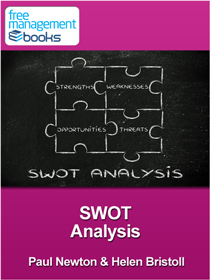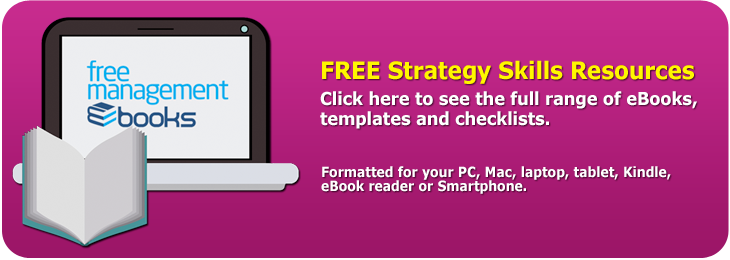SWOT Analysis - Free eBook in PDF Format
 |
 |
|
Book Description - ISBN 978-1-62620-951-0 (33 Pages)
This free eBook describes the SWOT analysis, a technique that you can perform for products, services, and markets when deciding on the best strategy for achieving future growth.
Chapter 1 - What is a SWOT Analysis?
The SWOT analysis is a business analysis technique that your organization can perform for each of its products, services, and markets when deciding on the best way to achieve future growth. The process involves identifying the strengths and weaknesses of the organization, and opportunities and threats present in the market that it operates in.
Chapter 2 - What definitions are needed for a SWOT Analysis?
The definitions of strengths, weaknesses, opportunities and threats are open to interpretation and a weakness of the SWOT technique is that it can be highly subjective. For example, if your organization was dependent on one single large distributor then this could be seen as a strength, as you would be able to get your products into the market quickly and efficiently. However, it could also be seen as a weakness because you are totally dependent on them to do so.
Chapter 3 - What is a SWOT internal analysis?
The internal analysis of your organization should include its culture, expertise, resources, and unique qualities within the market place. The extent to which your organization could adapt to changing circumstances is also a factor that needs to be considered.
Chapter 4 - What is a SWOT external analysis?
External factors include the environment your organization operates in, its market, ecosystem, and all of the third parties involved.
Chapter 5 - What is matching and converting?
Matching uses competitive advantage to pair strengths with opportunities. Converting means converting weaknesses or threats to strengths or opportunities. Matching and converting are useful ways of looking at the output from the SWOT analysis but both require a lot of debate and analysis rather than instant answers.
Chapter 6 - What are the advantages and disadvantages of a SWOT Analysis?
The most obvious limitations are: the risks of oversimplification; the fact that vested interests can prevent weaknesses and threats from being acknowledged; and the danger of information overload as there are no obvious limits as to what is and is not relevant.
Chapter 7 - Is there an example of a SWOT Analysis?
This example uses the international car manufacturer Audi to illustrate how the SWOT analysis can be applied at the organizational level. It is a well-known and popular example that is frequently used to illustrate SWOT in action.
SWOT Analysis: A Quick and Easy Way to Assess your Competition - Do you know how you stand when compared to the competition? If not, you need a quick and easy way to analyze your competition. The SWOT analysis is the ideal tool as it quickly and easily identifies Strengths, Weaknesses, Opportunities and Threats (SWOT).
Using the SWOT Analysis - As a manager, your role in any strategic planning is likely to involve providing operational data to help assess the internal capabilities, and (depending on your job function) you may also be asked to provide market intelligence. The completion of a SWOT analysis should help you to decide which market segments offer you the best opportunities for success and profitable growth over the life cycle of your product or service.
| You will learn: |
|
![]()
![]()
A Very Straightforward Approach to the Subject
I couldn't understand the benefits of using this analysis until I read this book because it broke things down for me in an easy to understand way.
I knew what SWOT stood for, but failed to understand what the specifics were regarding each letter. As far as a company's Strengths were concerned, I knew what to jot down for that section. The same goes with Weaknesses because I was able to identify where my small company lacked, so I wrote those down. The problem I was having was with Opportunities and Threats. I was unable to understand whether I should list internal or external opportunities and threats to complete this analysis.
This book guided me with a very straightforward approach to the subject. Strengths and weaknesses are internal factors over which an individual has measure and control. Opportunities and threats are factors which are external, over which an individual has no control. When I figured out this is what a SWOT analysis is about, it made me realize how valuable it is.
Another useful thing this book taught me was that this analysis can be used to guide strategy at the highest level and can also be tied to a specific business objective. I always wondered whether I should use the SWOT analysis for short term goals, and this book answered my question. Now I use this tool for a wide range of issues concerning my business, whether it is approaching another small business for a merger, or if I should launch a new product line.
One place I thought this book could improve is by giving real examples. I have always learned quickly when examples are put in front of me. So, if Free Management Books could take the time out to present some case studies about real companies, I think that I would be willing to pay for the book then rather than download it for free. I'm sure that other readers of this book have the same to say. But overall, great job on the book guys and thanks for finally making me understand what the SWOT analysis entails.
Dave Lawrence
This Book Was Really Helpful to Me
I have read all of the books in the "strategy skills" series and the only thing that I did not like about the books is that once you have read the first book you will realize that the other books start off the same way. I wish that the author would have been a little more creative with the introduction to these books. Even though I did not care for the way the book started out, the rest of the book is a must read. It is very informative and does a great job of describing the SWOT analysis tool. SWOT is a tool used for choosing the best way to enable growth for your business based upon products, markets, and services. SWOT stands for Strengths, Weaknesses, Opportunity, and Threats.
Strengths and weaknesses are internal factors and are factors which you have control over. Opportunities and threats you will not have control over and they are considered to be external factors. Taking those four categories into account, SWOT is meant to help guide you to make decisions to help your company grow. The book then defines strengths, weakness, opportunity and threats. The book defines them as: "Strengths-Internal factors that are favorable for achieving your organization's objective. Weaknesses-Internal factors that are unfavorable for achieving your organization's objective.
Opportunities-external factors that are favorable for achieving your organization's objective. Threats-external factors that are unfavorable for achieving your organization's objective." Even though the SWOT analysis tool can be really useful, it also has disadvantages. One disadvantage is that the person using it must use good judgment or it will not be effective. I like that the book went into further depth to help define what strength, weakness, opportunity, and threat are. Taking a closer look at each of those is important to help determine each category.
The book also did a great job of listing examples of each to help me better understand what n be considered a strength, weakness, etc. I thought that strengths and weaknesses were fairly easy to figure out. Opportunities I thought would be harder to understand without the examples. The next section of the book covers "matching" and "converting". I wish the author had spent a little more time on this aspect of the book. I felt that this section could have been a little longer. Matching is simply pairing strengths with opportunities. Converting is taking a weakness or a threat and turning it into a strength or opportunity. The author made this seem like it would be a fairly easy task, but it makes me wonder how simple it really is. This book does give the advantages and disadvantages of using the SWOT analysis tool, which I really found interesting.
In the end, I found that this book was really helpful to me. It was presented clearly and was easy to understand. The only problem I had with this book was the "matching and converting" section. I would recommend this book for others to read. Without having a lot of knowledge about this, I feel that after reading this short book, I now have a pretty good understanding of it.
Derrick Schultz
Using the Boston Matrix - The Boston Matrix was developed to help organizations allocate their investments across its product range and divisions. However, it is sometimes used as part of brand level decision-making - something it was never designed for. Many of the misconceptions associated with the Boston matrix come from the nature of the economic climate that existed at the time of its inception. These fundamental assumptions were incorporated into its design and are not always applicable in today's global fast-paced market.


